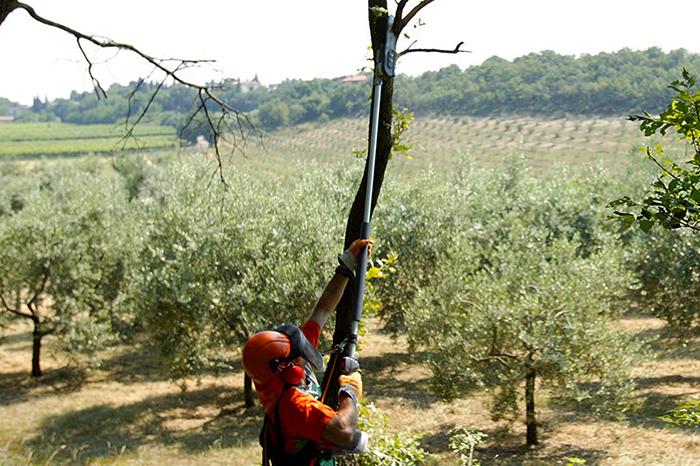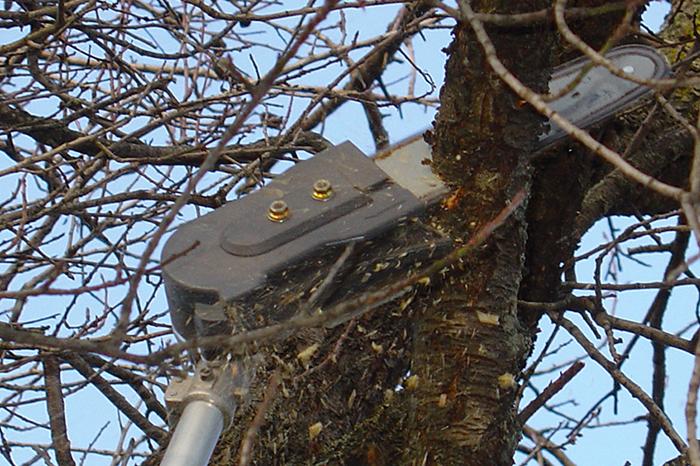The best pruner for high branches

In the nursery and garden pruning is an essential task to achieve generous blooms and crop yields, to limit the spread of disease, and also to keep the required shape of trees and shrubs due to requirements of space or safety, or for ornamental vegetation.
Pruning plants correctly is an art form. You need to always be aware of why, when and how to prune and understand when it's time to desist to avoid over-pruning or cutting back to the point that instead of stimulating healthy growth you are actually damaging the tree or harming its appearance.
Clearly, correct working methods and, especially, suitable pruning tools are indispensable for the perfect outcome of your pruning activities. Follow us to discover the must-have tools in your gardening equipment.
Tools for pruning high branches and pruning tall trees
Tools for pruning tall trees and high branches in general can be manual or petrol-engine, electric or battery-powered. The common factor of pruners for high branches, including manual and power tools, is the handle with telescopic pole that greatly increases the range of action: you can make cuts at height while remaining on the ground. This means there's no need to resort to ladders, so you can work more safely.
The difference between the various types of telescopic pruners, meaning tools with a telescopic pole, designed for pruning tall trees and cutting high branches, concerns the cutting equipment of the tool, which can be:
- a bar with chain, as in a chainsaw;
- a pruning saw with a toothed blade;
- a lopper, meaning a shearing tool with return spring and contoured blades.
Manual tools, recommended for less expert users, include pruning saws such as Oleo-Mac model SRM35T4 with a 35 cm curved blade in chrome plate steel, with its properties of exceptional hardness and corrosion resistance. This tool is then completed with the dedicated telescopic pruning saw pole, lightweight and extendable, to allow cutting at heights in excess of 5 metres.
The best pruner for high branches
The best pruner for high branches in terms of power and performance is indubitably the petrol-engine telescopic pruner. While you can cut limbs of up to 3-3.5 cm with a pruning saw and lopper, you will be able to take on thicker limbs of up to 8-10 cm in diameter with a petrol-engine pruner. And that's not all: with models such as the Oleo-Mac PPX 271, with 1 kW 2-stroke engine with 27 cm3 displacement and reach of 3.8 m, you can cut limbs at up to around 5 m from the ground.
Make cuts even more easily by adjusting the 25 cm bar (21 cm cutting length), which has five positions from 0 to 90°, so that it is always in the most practical and the safest position with respect to the limb to be cut.




Looking for a multi-purpose tool? Then you need a brushcutter-pruner. The amazing Oleo-Mac machine that is the result of the combination of the multifunction brushcutter and its pruner application: This means you have a pruner for high branches with a fixed pole with a total length of 2 m, allowing cutting at up to 3.5 m above the ground.
Better a lopper, pruning saw, or pruning chainsaw? Fixed pole or telescopic pole?
Obviously, apart from the objective performance of the various tools, to decide which is the best pruner for your needs you must consider several factors, first of all your cutting requirements and the surroundings in which you are working. If you are pruning ornamental shrubs, climbing plants and evergreen hedges in the garden, you can probably handle the work with a manual pruning saw and a lopper. Conversely, if you are to cut conifers in woodland areas or fruit trees in the countryside, the best option will be a petrol-engine pruning chainsaw.
Also the age and size of the trees can affect the choice, as can your personal experience and physical stature.


Hacks and tips for cutting tall trees and high branches with a pruner
Earlier we said that also correct working methods are important to achieve optimal pruning results.
In general, the most important rule to observe is to keep the pruner bar in a position that makes it possible to cut the branch at the correct distance from the trunk. Leaving an excessively long branch stub or cutting too close to the trunk will result in the creation of points exposed to parasite attack.
The cut should be slightly angled with respect to the trunk and the cut surface should be completely smooth, without notches and steps and certainly without splintering. This is applicable for both trees and shrubs, whether using a petrol-engine pruner or a pruning saw with telescopic pole.
If the branches are thick, making a single cut results in the risk of tearing, so adopt the relieving cut technique, cutting the branch into several sections each around 20 cm in length. Each cut is performed in 2 steps: make an initial cut on the underside of the branch to about one quarter of the thickness, then make a second cut from top to bottom, reaching the end of the first cut and thus severing the branch.
As mentioned, you must always assume the safest possible position when working with a pruner. Grip the rear handle (control grip) with your right hand and grip the pruner shaft with your left hand. Your balance will be more secure if you hold the pruner as close as possible to your body, although obviously leaving sufficient distance from the muffler and chain.
Hold the pruner in the optimal position, meaning the least tiring and safest one: never stand under the branch you are cutting and always incline the pruner so that it forms a maximum angle of around 60° with respect to the ground. Apart from enjoying greater working comfort because the weight of the tool is balanced, in this manner you will also be working in safety because you are outside the zone at risk of falling branches. Use the utmost caution anyway: branches can bounce considerable distances after first hitting the ground.
To aid the descent of pruned branches, cut the lowermost branches first.



